Classificatie, synthese en toepassing van luminescente silica-nanodeeltjes:een recensie
Abstract
Luminescerende materialen zijn wereldwijd interessant vanwege hun unieke optische eigenschappen. Silica, dat transparant is voor licht, is een ideale matrix voor lichtgevende materialen. Luminescente silica-nanodeeltjes (LSN's) hebben brede toepassingen vanwege hun verbeterde chemische en thermische stabiliteit. Silicabolletjes van verschillende afmetingen kunnen op verschillende manieren worden gesynthetiseerd om aan specifieke eisen te voldoen. Diverse luminescente kleurstoffen hebben potentieel voor verschillende toepassingen. Onder voorbehoud van vele factoren, zoals quenchers, was hun prestatie niet helemaal bevredigend. Deze review bespreekt dus de ontwikkeling van LSN's, inclusief hun classificatie, synthese en toepassing. Het is het hoogtepunt dat hoe silica de eigenschappen van luminescente kleurstof verbetert en welke rol silica in het systeem speelt. Verder worden hun toepassingen in biologie, weergave en sensoren ook beschreven.
Inleiding
Luminescerende materialen worden veel toegepast vanwege hun bijzondere optische eigenschappen [1]. De toepassing ervan wordt echter beperkt door vele beperkingen, zoals lage hydrofobiciteit en biocompatibiliteit, of vanwege nadelen, zoals hoge toxiciteit, slechte biocompatibiliteit en lage absorptie [2,3,4,5]. Het is dus noodzakelijk om luminescente materialen aan te passen om te voldoen aan de eisen van praktische toepassingen.
LSN's met verbeterde eigenschappen krijgen steeds meer aandacht in de biologie [6, 7], verlichting [8] en sensoren [9]. Hun karakteristieke optische eigenschappen maken ze uniek in optische materialen [10]. Silica is lichtdoorlatend, wat silica een ideale kandidaat maakt als matrix voor fluorescerende materialen. Thermodynamische en chemische stabiliteit zijn ook belangrijke factoren, aangezien een matrix en silica samenvallen met deze basisfactoren [11]. Bovendien kan het oppervlak van silica gemakkelijk worden aangepast, waardoor verdere functionalisering met verschillende functionele groepen mogelijk is om verschillende vereisten aan te passen [12]. Silica met veel van de bovengenoemde voordelen is natuurlijk een ideaal substraat voor het verbeteren van de eigenschappen van luminescerende materialen [13]. Multifunctionele nanosystemen kunnen worden gecreëerd door het assembleren, inkapselen of integreren van een of meer verschillende nanomaterialen in en op het oppervlak van silica nanodeeltjes met behulp van verschillende processen [11]. Als modificerende luminescente materialen trekken LSN's met de uitstekende eigenschappen steeds meer aandacht in grensverleggende onderzoeken [14]. Montalti et al. somde vele uitstekende onderzoeken op in medische beeldvorming met organische kleurstoffen gedoteerd silica [6]. Silica biedt een stabiel en multifunctioneel platform voor fosforen, maar de toxiciteit op lange termijn moet worden bestudeerd. Michael Schäfrling demonstreerde de kunst van lichtgevende sensoren [9]. Selectiviteit en gevoeligheid vormen de kern van de sensormaterialen. Zou Hua et al. uitgewerkt op de middelen van organische silica modificatie. Nanocomposieten hebben superieure eigenschappen om componenten te scheiden [15]. Er zijn veel wonderreviews die zich richten op een specifiek gebied zoals biologie [6, 7, 16], maar zonder een systematische introductie tot LSN's en hun uitstekende prestaties op andere gebieden.
Deze beoordeling begint met de classificatie van LSN's, gevolgd door hun synthetische methoden. De categorieën LSN's worden systematisch vastgesteld op basis van de classificatie van lichtgevende materialen. In termen van chemische eigenschappen en luminescentiemechanismen zijn organische molecuulkleurstoffen, luminescent metaal en kwantumdots (QD's) gedoteerde fosforen drie typische fosforen, die allemaal hun eigen unieke luminescentiemechanismen en voordelen hebben als vertegenwoordigers van LSN's [17,18,19 ]. Het hoogtepunt is hoe het silica de eigenschappen van fosforen verbetert. Met het gebrek aan toepassingen van luminescente materialen, worden de mogelijke strategieën besproken om hun prestaties voor LSN's te verbeteren. Het gaat niet alleen om biologische toepassingen, maar ook om displays en sensoren.
Classificaties van LSN's
Luminescentie die verschillende helderheid uitstraalt, heeft grote waarde in materiële velden [20]. Er is veel onderzoek gedaan naar de modificatie van luminescerende materialen om de signaal-ruisverhouding, de stabiliteit en het aanpassingsvermogen aan de omgeving voor de mogelijke toepassingen te verbeteren. De introductie van antenneliganden in lanthanidecomplexen om de luminescentieprestaties te verbeteren is een typisch voorbeeld van modificatie. Silica is een goede matrix voor het mengen van materialen met verschillende functies en verschillende chemische eigenschappen. Fosforen zijn gedoteerd in silicamatrix om hun natuurlijke defecten te wijzigen en hun eigenschappen te verbeteren, wat voordelig is voor brede toepassingen met gemakkelijk gemodificeerde en niet-toxische silica-oppervlakken en bescherming voor luminescerende kleurstoffen. Met multifunctioneel en afstembaar aanpassingsvermogen hebben LSN's steeds meer aandacht getrokken. Van alle luminescente fosforen zijn organische luminescente moleculen, luminescente met metaal gedoteerde fosforen en QD's de drie meest representatieve categorieën die aandacht verdienen. Dus de bovenstaande drie kleurstoffen worden weergegeven als typische LSN's in combinatie met silica. Representatieve voorbeelden staan vermeld in tabel 1.
Organische lichtgevende moleculen gedoteerde LSN's
Organische luminescerende moleculen zijn belangrijke luminescerende materialen met π-geconjugeerde ringstructuren en kleine afmetingen [16]. Niet-specifieke etikettering en bleken belemmeren echter hun toepassing. Met organische kleurstoffen gedoteerde silica-nanodeeltjes worden veel bestudeerd met uitstekende stabiliteit, selectiviteit en biocompatibiliteit [52, 53]. Van Blaaderen et al. [21] deed een voorlopige poging om lichtgevende silicabolletjes te synthetiseren. Fluoresceïne-isothiocyanaat (FITC) werd op het oppervlak van silica gecoat met behulp van APS ((3-aminopropyl)triethoxysilaan), wat een haalbare manier bood om kleurstoffen met silica te combineren door covalente bindingen. Geïnspireerd door dit proces, Andrew et al. [22] gesynthetiseerd dual-emission fluorescerende silica nanodeeltjes met twee lagen. Twee kleurstoffen, tetramethylrhodamine-isothiocyanaat (TRITC) en FITC, werden door middel van APS aan het silica geconjugeerd in een watervrije stikstofomgeving. Het schematische diagram en de SEM-afbeelding (Fig. 1a) toonden de nanostructuren van de nanodeeltjes. Silica met TRITC werd eerst gesynthetiseerd als de kern van de nanodeeltjes met dubbele emissie en FITC werd op het oppervlak van de kern geconjugeerd met verder tetraethoxysilaan (TEOS). De gesynthetiseerde fluorescerende silica-nanodeeltjes met dubbele emissie onderzochten de intracellulaire pH-waarde met succes in basofiele leukemie-mestcellen van ratten (RBL-2H3) in Fig. 1b-d.
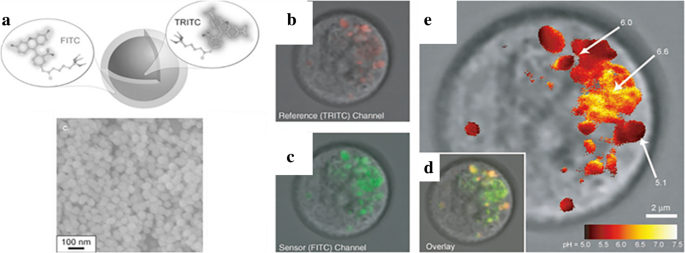
een Het vormingsdiagram en scanning-elektronenmicroscoop (SEM) beeld van fluorescerende silica-nanodeeltjes met dubbele emissie met referentiekleurstof (TRITC) en sensorkleurstof (FITC); het confocale fluorescentiemicroscopiebeeld van RBL-mestcellen (rood als TRITC-silicadeeltjes en groen als AlexaFluor 488-choleratoxine B); confocale fluorescentiemicroscopiebeelden van RBL-mestcellen als pH-sensoren. b Voor referentiekanaal, c voor sensorkanaal, d voor de overlappende afbeeldingen, en e valse-kleuren ratiometrische beeldvorming voor pH-waarden berekend volgens de experimenten [22]
Om de fotostabiliteit van organische fluoroforen te verbeteren, is inkapseling van silica een veelgebruikte modificatiemethode. Lange Jiao et al. [23] koos vier aminocyaninekleurstoffen als de nabij-infrarood (NIR) fluorescerende sondes en koppelde ze dienovereenkomstig aan 3-aminopropyltriethoxysilaan (APTES), een veelgebruikt silaankoppelingsmiddel. TEOS hydrolyseerde met de behandelde NIR-kleurstoffen in het micro-emulsiesysteem. De met cyanine beladen fluorescerende silica-nanodeeltjes (FSNP's) werden verkregen na centrifugeren en wassen. Het hele proces werd getoond in Fig. 2a. Zoals te zien is in figuur 2b, vertoonden de vier FSNP's ingekapseld in het silica een betere pH-stabiliteit van de fluorescentie-intensiteit dan die van vrije kleurstoffen. De vier FSNP's verbeterden tegelijkertijd hun helderheid (figuur 2c). Ze testten hun fotostabiliteit in levende cellen met een confocale laser scanning microscoop (CLSM). FSNP-3 en FSNP-4 (meer verankeringsplaatsen) kregen een verbeterde fotostabiliteit dan die van vrije kleurstoffen, terwijl FSNP-1 en FSNP-2 geen enkele verbetering kregen. Meer verankeringsplaatsen versterkten de structuur van het kleurstofmolecuul. Een kleurstof met een stijve structuur had een minder niet-stralingsverval en harde intramoleculaire rotatie waardoor de kleurstof helderder werd. Silicalaag kan de ingekapselde materialen beschermen die de molecuulstructuur hebben versterkt en hun helderheid verbeteren zonder fotobleken. FSNP-3 en 4 hadden ook een lage biologische toxiciteit volgens de methyltetrazolium (MTT) -methode in figuur 2d. Biocompatibiliteit is een ander voordeel van silica.
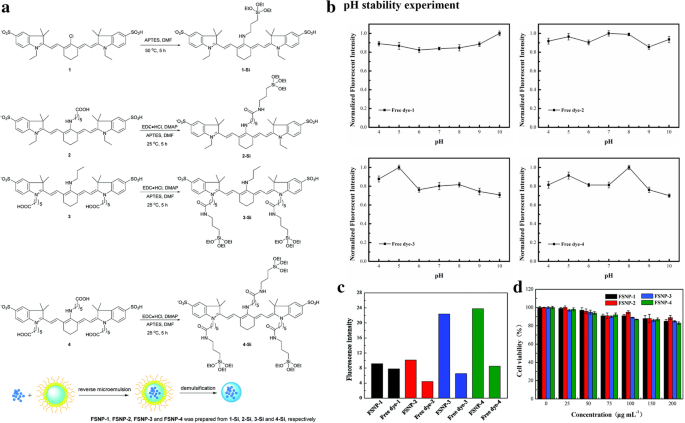
een Het mechanisme van FSNP-1, FSNP-2, FSNP-3 en FSNP-4. b De genormaliseerde intensiteit in verschillende pH-waarden van alle monsters. c Emissie-intensiteit van de FSNP's en vrije kleurstoffen. d De levensvatbaarheid van de raw264.7-macrofaagcellen [23]
toont na 24 uur incuberen met FSNP'sAgglomeratie is een van de belangrijkste redenen voor het doven van de meeste luminescente kleurstoffen. Fosforen kunnen met silica gestaag in een geschikte concentratie worden gehouden. Aggregatie-geïnduceerde emissie-luminogenen (AIE-genen) hebben, in tegenstelling tot de traditionele luminoforen, geen last van dit probleem. Omgekeerd leidt aggregatie tot sterke emissie [54]. Om de prestaties van AIE-genen in biologische velden te verbeteren, worden veel polymeermatrices gebruikt om AIE-genen in te kapselen. Bovendien zijn er enkele andere zaken die AIEgens-quenching kunnen veroorzaken, zoals water en zuurstof, wat een negatief effect heeft op de applicatie. Silica kan voorkomen dat ze uit de quenchers komen [55]. Op basis van deze analyse hierboven, werd TPETPAFN (een typisch fluorogeen bestaande uit twee tetrafenylethyleenhangers en een intramoleculaire ladingsoverdrachtskern), een AIEgen, biologisch gefunctionaliseerd door F127 (poly (ethyleenglycol)-blok-poly (propyleenglycol)-blok-poly ( ethyleenglycol)) om de kernmicel te vormen [24]. TEOS werd gehydrolyseerd om via een gemodificeerde sol-gel-methode een op de kernmicel gecoate silicaschaal te verkrijgen. Zoals figuur 3 liet zien, was de synthetische TPETPAFN-F127-SiO2 nanodeeltjes vertoonden betere fotoluminescentie-eigenschappen en profiteerden van de bescherming van de silica-omhulling.
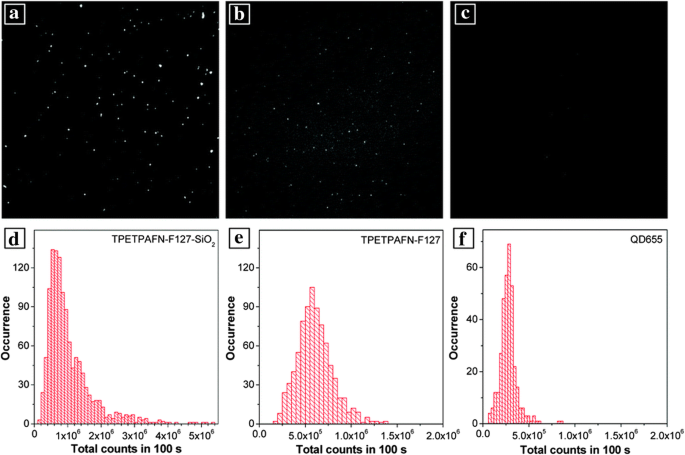
een , d De afbeeldingen van fluorescentie en de histogrammen van fotonen van TPETPAFN-F127-SiO2 tonen NP's, overeenkomend met b , e voor TPETOAFN NP's en c , v voor commerciële QD655 [24]
Lichtgevende, met metaal gedoteerde LSN's
Zeldzaam aardmetaal [56] en overgangsmetaal [57] zijn veelvoorkomende materialen van luminescentiemetaal op basis van de overgang van ladingsoverdracht. Luminescentie na complexeren met het ligand is het meest voor de hand liggende kenmerk van dit materiaal. Er zijn twee hoofdmechanismen van metaalluminescentie, LMCT (overgang van ligand naar metaallading) en MLCT (overgang van metaal naar ligandlading). Lanthanidemetalen en overgangsmetalen zijn respectievelijk hun typische voorbeelden. Vanwege overvloedige elektronische energieniveaus zijn er diverse luminescente metalen die een groot potentieel hebben voor toepassing op het gebied van luminescentie met verschillende emissies [58]. Edelmetalen met LSPR zijn op grote schaal gebruikt in materialen met verbeterde luminescentie en zijn betrokken bij deze sectie. Desalniettemin beperken lage sensibilisatie-efficiëntie en uitdoving de toepassingen van luminescerende metalen [59]. Om hun fotostabiliteit en biocompatibiliteit te verbeteren, hebben Francis et al. voegde een gesubstitueerde silylgroep toe aan de liganden voor de verdere modificaties [30]. Eu@Si-OH-nanodeeltjes werden verkregen na het coaten van met silylgroep gemodificeerde Eu-complexen met silica via omgekeerde micro-emulsiemethode. Het product kreeg uiteindelijk amine gefunctionaliseerd met APTES als Eu@Si-NH2 nanodeeltjes. De silicalaag hield de complexen uit de quenchers (OH en NH2 groepen). Als resultaat vertoonden ze allebei een betere fotostabiliteit in Fig. 4. Eu@Si-NH2 nanodeeltjes vertoonden goede prestaties bij bio-imaging.
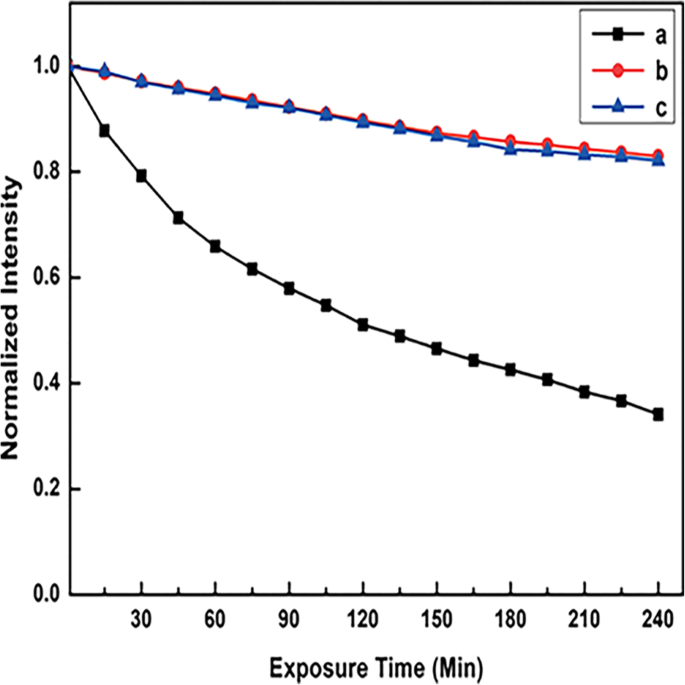
De curven van de fluorescentie-intensiteit veranderen met de belichtingstijd onder 365 nm bestraling, a ouder Eu-complex in CHCl3 oplossing, b Eu@Si-NH2 , en c Eu@Si-OH nanodeeltjes in fosfaatgebufferde zoutoplossing (PBS) bufferoplossing [30]
Ezquerro et al. integreerde Ir-complexen, MLCT luminescent complex, in het silicaraamwerk voor verbeterde stabiliteit en fotofysische eigenschappen via sol-gel-proces [60]. Met de bescherming van silica vertoonden deze fosforen een uitstekende stabiliteit, niet alleen onder omgevingsomstandigheden, maar ook onder zware omstandigheden die verder worden toegepast in witte lichtemitterende diodes (WLED).
Y. Li et al. [31] gesynthetiseerde oliezuur-gestabiliseerde upconversion nanodeeltjes (UCNP's). Vervolgens bedekten ze een silicalaag op de UCNP's via een micro-emulsiemethode en werden in water oplosbare UCNP's verkregen. Introductie van Eu (TTA)3 phen-complexen in het systeem, synthetiseerden ze NaGdF4 :Yb,Er@SiO2 @Eu (TTA)3 Phen (UCNPs@SiO2 @EuTP) nanosferen. Het afschrikken van het oppervlak werd onderdrukt na het coaten van silica en als gevolg daarvan nam de emissie-intensiteit toe, zoals weergegeven in figuur 5. De in water oplosbare nanodeeltjes met twee verschillende emissies werden verkregen met behulp van silica.
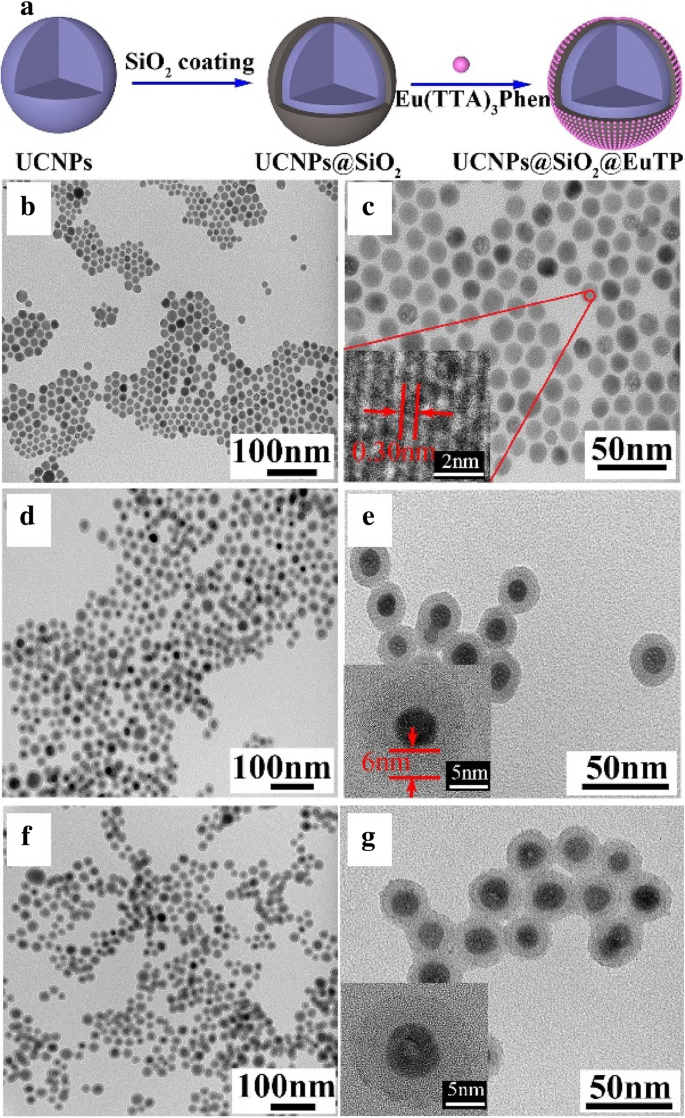
een De vorming van UCNPs@SiO2 @EuTP en TEM (transmissie-elektronenmicroscoop) afbeeldingen van de monsters; b , c voor UCNP's, d , e voor UCNPs@SiO2 , en f , g voor UCNPs@SiO2 @EuTP [31]
Chen et al. [42] gebruikte met succes carbon dots (CD's) en zeldzame-aarde-ionen voor WLED. Ze synthetiseerden cd's met een organische pyrolyse-methode met één pot, die een maximale blauwe emissie had bij 470 nm en twee excitatiepieken bij respectievelijk 251 en 364 nm. Om wit lichtuitstralend composiet te krijgen, werden cd's gebruikt als de blauwe emissiekern en Sr2 Si5 N8 :Eu 2+ fosfor werd gebruikt als de oranje emissiecomponent. Er werden cd's in het Stöber-systeem geplaatst. Terwijl TEOS hydrolyseerde, zouden cd's worden gecoat met een silicalaag met rode fosfor. De carbon dot-silica-phosphor composiet (CDSP) werd gesynthetiseerd na centrifugeren, drogen en malen. CDSP had een brede absorptie variërend van het UV (ultraviolet) tot gele gebied (200-600 nm), vooral sterk in het UV-gebied. Na het testen van excitatie op verschillende golflengten, ontdekten ze dat de CDSP de coördinaat van de Commission Internationale de l'Eclairage (CIE) (0,32, 0,32) in de kast kreeg naar die van puur wit licht (0,33, 0,33) bij de excitatie bij 400 nm in Fig. 6. En het was een goede poging om de emissie van CDSP te krijgen door de massaverhouding van CD en de fosfor af te stemmen. Onder excitatie bij 400 nm kregen ze de dichtstbijzijnde massaverhouding (3,9% (0,32, 0,32) en 5,1% (0,34, 0,32)) tot witte emissie. CDSP vertoonde een betere witte emissie (0,30, 0,31) in light-emitting diode (LED) verpakkingen dan die van CD&P (direct vermengd met cd's en fosfor) (0,28, 0,29). Twee componenten werden homogeen gedispergeerd met silica en verminderden de kans op aggregatie en fasescheiding. Ten slotte kregen ze een WLED met CDSP-poeder op een UV-diodechip (375 nm) en werd een wit licht (0,30, 0,33) verkregen. De kleurweergave-index (CRI) was ongeveer 94, hoger dan die van de op YAG:Ce gebaseerde commerciële WLED (CRI < 75).
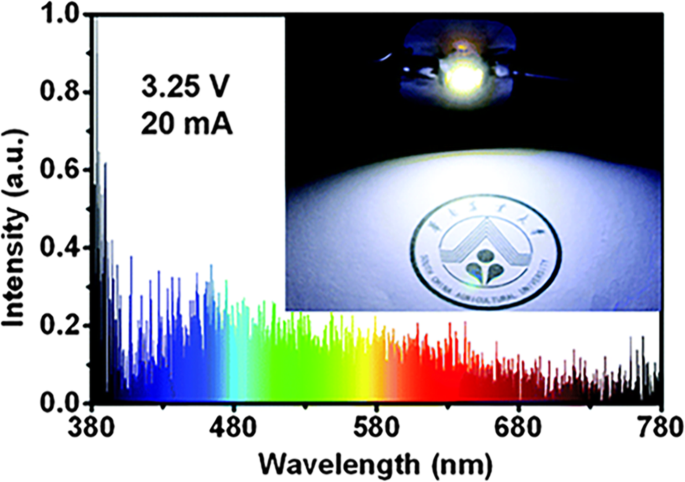
De prestaties van op CDSP gebaseerde WLED:emissiespectra en foto [42]
Silica wordt vaak gebruikt als beschermende laag voor luminescerende materialen om voldoende afstand te houden van edele metalen om de fluorescentie te versterken. Dit komt door de staande oscillatie van vrije elektronen veroorzaakt door licht. Om de luminescentie te versterken, moet het op een geschikte afstand tussen kleurstoffen en edelmetaaldeeltjes worden gehouden. Wat betreft edele verbeterde materialen, metalen nanodeeltjes zelf kunnen ervoor zorgen dat de chromoforen uitdoven (binnen 5 nm), maar hun fluorescentie kan 100-voudig toenemen (ongeveer 10 nm). In het vroege onderzoek, Tuo Li et al. [61] gesynthetiseerde Ag-nanodeeltjes met de silicaschil in de micro-emulsiematrix (Ag/SiO2 nanodeeltjes). De reagentia die nodig zijn om silica (TEOS en cyclohexaan) te produceren, werden in de micro-emulsie geïnjecteerd nadat het zilver was gereduceerd. Ze bestudeerden zorgvuldig de effecten van verschillende omstandigheden (water/surfactant voor R en water/TEOS voor H) op de Ag/SiO2 nanodeeltjes en de resultaten getoond als Fig. 7. Het is een goede manier om een uniforme en dikke silicalaag op de kern te coaten, niet alleen Ag maar ook andere nanodeeltjes met een micro-emulsiesysteem. Wat Zhenhua Bai et al. [25] deed is een goed voorbeeld. 8-Hydroxypyreen-1, 3, 6-tresulfonzuur (HPTS), een soort fluorescerende pH-gevoelige kleurstoffen, is vanwege zijn unieke voordelen geschikt om te maken als intracecellulaire pH-sensoren. Maar extreme pH-omstandigheden maakten het ongevoelig. Wanneer de oplossing zuur is, zou de efficiëntie van de fluorescentie aanzienlijk afnemen. HPTS-geadsorbeerd Ag@SiO2 nanodeeltjes (Fig. 8a) werden bereid op basis van met edelmetaal versterkt fluorescentie-effect. Uit figuur 8b blijkt dat Ag@SiO2 -8 nm@HPTS vertoonde een betere fluorescentie-intensiteit, vooral in de extreme pH-omstandigheden.
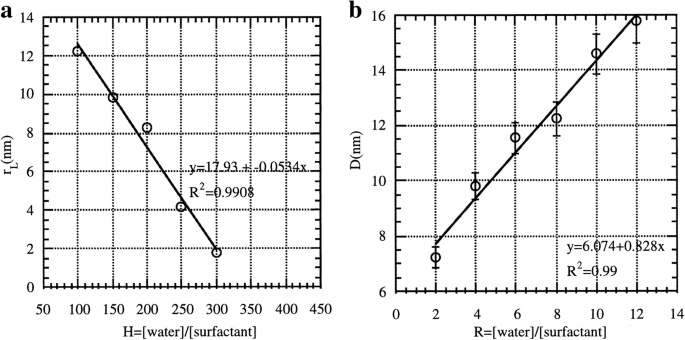
een De grootteverandering als functie van H (R = 4 en X = 1); b wanneer R is variabel, de grootteverandering van Ag-clusters [61]
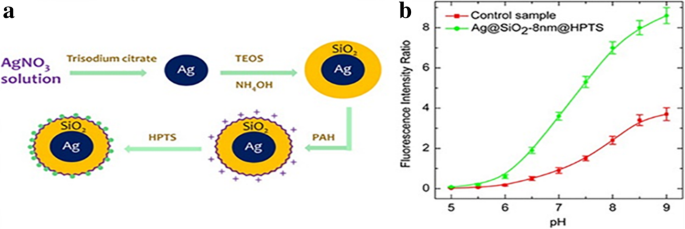
een De voortgang van de synthese van HPTS-geadsorbeerd Ag@SiO2 nanodeeltjes. b De fluorescentie-intensiteitsverhouding van Ag@SiO2 -8 nm@HPTS (groen) en controlemonster (rood) [25]
Met QD's gedoteerde LSN's
Vanwege het kwantumbegrenzingseffect vertonen QD's uitstekende luminescentie-eigenschappen, of het nu halfgeleider-QD's, koolstof-QD's of andere typen zijn. Onlangs hebben talrijke onderzoeken zich gericht op de toepassingen van QD's in optische apparaten. Soms zijn hun eigenschappen niet goed genoeg om de complexe toepassingen aan te passen. Noodzakelijke modificatie is noodzakelijk en silica is een geschikte matrix [1].
Om de combinatie van biolabel en magnetische resonantiebeeldvorming te realiseren, werden CdSe QD's gecoat op de magnetische Fe2 O3 kern door een silicalaag met NH2 groep. De bijbehorende afbeeldingen en karakteriseringen werden getoond in Fig. 9. Gecombineerde NH2 groep met bio-verankerd membraan (BAM), 4 T1 muizenborstkankercelmembranen vertoonden specifieke labeling met BAM-SiO2 -CdSe MQD's [44]. Met de biocompatibiliteit en magnetische, zouden de multifunctionele luminescentie nanodeeltjes brede toepassingen in de geneeskunde krijgen.
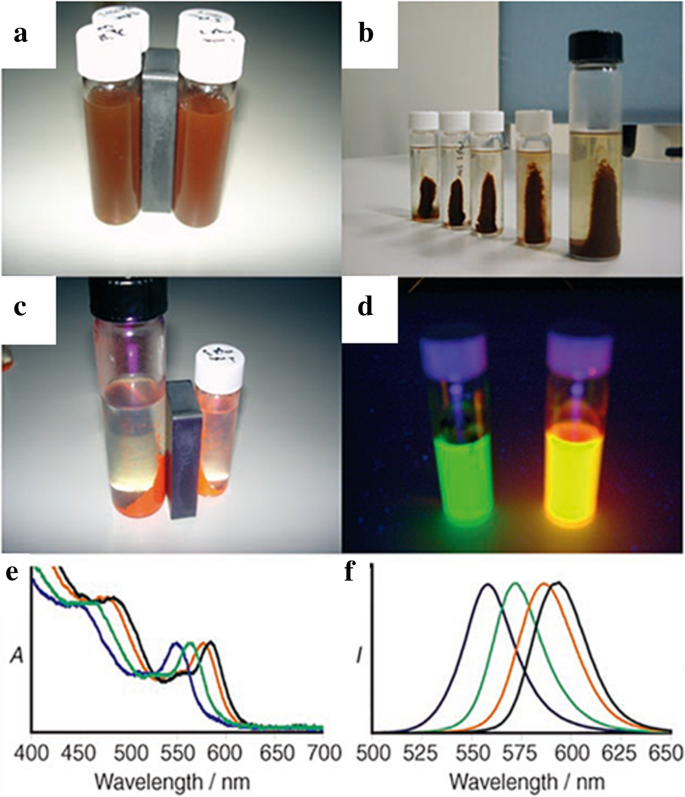
De foto's onder normaal licht om de magnetische wijziging te bewijzen (a , b ). c De foto onder UV-licht om zowel de magnetische als de luminescentie-eigenschappen te bewijzen. d De UV-foto van groene en oranje magnetische kwantumdots (MQD's). e , v De luminescentiespectra van SiO2 -MQD's in PBS-oplossingen (e voor absorptie en f voor emissie) [44]
Om de toepassing van QD's te verbreden, is het noodzakelijk om hun oplosbaarheid in water en niet-toxiciteit te wijzigen. Silica vertoont een groot potentieel in de modificatie van QD's. Yunfei Ma et al. [43] introduceerde een zelfgemaakte faseoverdrachtsreagens (adenosine 5′-monofosfaat, AMP) en silaankoppelingsmiddel (3-mercaptopropyltrimethoxysilaan, MPS) in het Stöber-systeem. In olie oplosbaar (initiële CdSe/CdS/ZnS QD's), in alcohol oplosbaar (AMP-QD's) en in water oplosbaar (hydrolyse van TEOS rond de QD's) waren de hele vooruitgang van de oplosbaarheidsverandering. QD@SiO2 had dezelfde fotoluminescentie-efficiëntie (50-65%) als de eerste. Een breder pH-bereik (pH 4–8 tot 2-13), verbeterde stabiliteit in elektrolyt, betere thermische stabiliteit en verhoogde biocompatibiliteit in Hela-cellen waren de voordelen van de QD@SiO2 .
Om de stabiliteit van QD's in optische apparaten te garanderen, is het noodzakelijk om het effect van knipperen te verminderen. Knipperen is een fenomeen met een willekeurige intermitterende luminescentie die de stabiliteit van de optische QD's beïnvloedt [62]. Om het effect van knipperen te verminderen, hebben Botao Ji et al. [45] produceerde CdSe/CdS QD's als de kernmaterialen en kapselde deze QD's in een silicaschaal op basis van de verplaatsing van de initiële hydrofobe liganden door omgekeerde micro-emulsiemethode. En de QD's verder gemodificeerd door een Au-laag op het oppervlak van silica met poly (1-vinylimidazol-co-vinyltrimethoxysilaan) (PVIS) als het silaankoppelingsmiddel. De gouden schaal van nanoformaat fungeerde als een plasmonresonator die de QD's een verbeterde optische toestandsdichtheid gaf. Door de hybride laag kunnen de eigenschappen van de QD's behouden blijven ondanks drastische veranderingen in de lokale omgevingen. Als gevolg hiervan nam de fotostabiliteit van de QD's toe. De levensduur van de QD-fluorescentie nam af van 123 tot 20 ns na goudcoating. De gouden QD's vertoonden efficiënte multi-exciton-emissie en de neutrale fotoluminescentie-intensiteit was hoger dan die van QD's. De resultaten van de stabiliteitstest werden getoond in Fig. 10. Bovendien kon de fotoluminescentie-intensiteit enkele uren stabiel blijven (zelfs 24 uur). De luminescentiestabiliteitstest toonde aan dat de luminescentie van kale QD's na slechts 1 uur een dramatische daling zou hebben. Silicalaag verbeterde de prestaties van QD's enigszins, maar bood het geschikte interval voor de volgende Au-laag om het door plasma versterkte effect te laten zien.
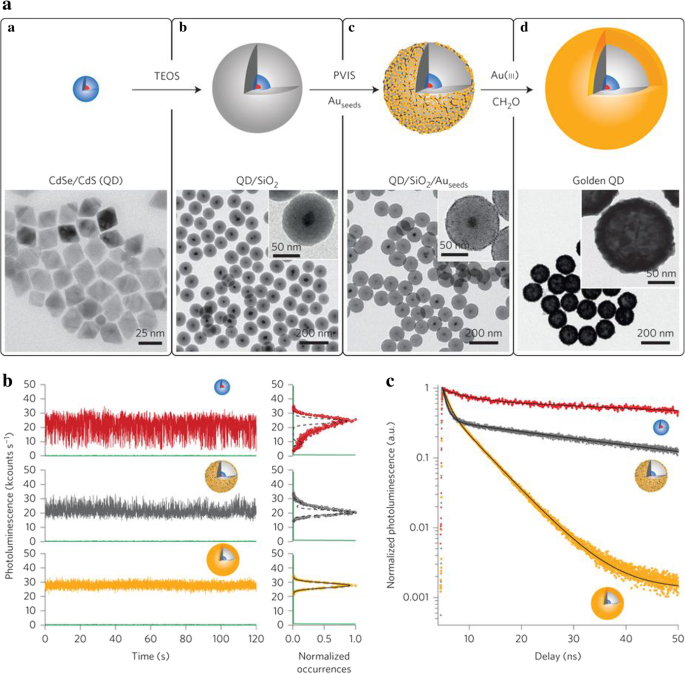
een Schema van kwantumdot/SiO2 /Au hybride (gouden QD) en de TEM-beelden van elke fase (CdSe/CdS QDs, QD/SiO2 QD/SiO2 /Auzaad en gouden QD's). b De verandering van fotoluminescentie-intensiteit met de tijd. Rood voor CdSe/CdS, grijs voor QD/SiO2 /Auzaad , en oranje voor gouden QD's. c Fotoluminescentie-vervalcurves van drie nanodeeltjes in (b ) [45]
Synthetische methoden van LSN's
Voor de fabricage van LSN's zijn de selectie van fosforen en het ontwerpen van synthetische routes de kerninhoud. Fosforen bepalen het emissiebereik van LSN's en synthetische routes bepalen hun structuren en functies. Alle synthetische routes van LSN's zijn gebaseerd op het silica. Sol-gel-methode, omgekeerde micro-emulsiemethode en directe micellen-assistentmethode zijn drie belangrijke benaderingen om homogene en regelmatige silicabolletjes te verkrijgen die in LSN's zijn gebruikt. Afbeelding 11 is het schematische diagram van de genoemde methoden.
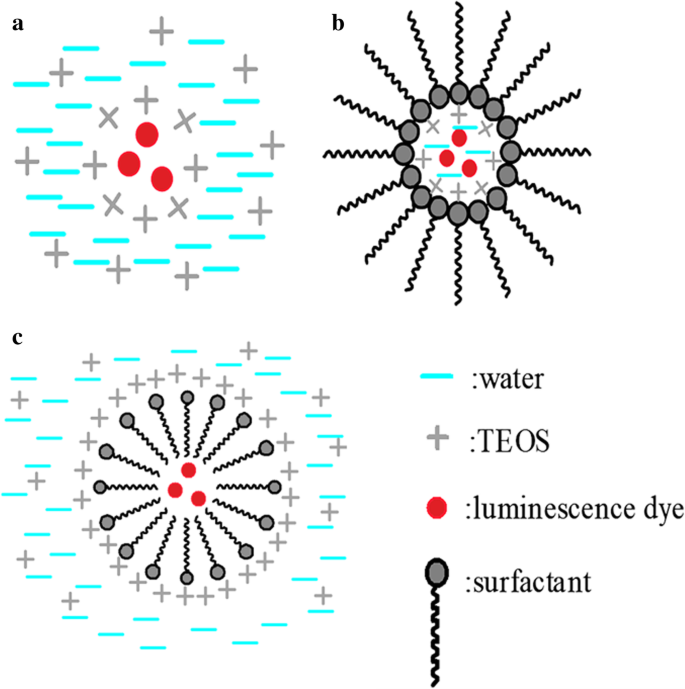
De schematische illustraties van verschillende LSN's met verschillende methoden. een Voor de Stöber-methode. b Voor de omgekeerde micro-emulsiemethode, c Voor directe micellen-assistentiemethode
Sol-Gel-methode
Sol-gel-methode, ook wel Stöber-methode genoemd, is een handige en haalbare methode om monogedispergeerde silica-nanobolletjes te verkrijgen. Het is ideaal om silica-nanobolletjes te synthetiseren, aangezien Stöber [63] de synthese van groottespecifieke silicabolletjes in het bereik van 50 nm-2 μm zorgvuldig bestudeerde, waarbij alkoxysilaan hydrolyseerde onder ammoniakkatalyse. Homogene silicabolletjes met verschillende groottes (10 tot enkele honderden nanometers) kunnen eenvoudig worden verkregen door de syntheseomstandigheden zoals de ethanol-tot-waterverhouding, de hoeveelheid ammoniak en de temperatuur te regelen via de sol-gel-methode. Met behulp van de Stöber-methode hebben Van Blaaderen en A. Vrij Langmuir met succes kleurstof (FITC) gedoteerd silica gesynthetiseerd door (APS) toe te voegen aan het reactiesysteem [21]. Met de aminegroep van APS vingen silicabolletjes gemakkelijk FITC op, zoals getoond in figuur 11a. Tot nu toe zijn, naast kleurstoffen, veel andere materialen via de Stöber-methode aan silica gekoppeld. Luis M. Liz-Marzan et al. verbeterde de Stöber-methode en synthetiseerde goud-silica kern-schaaldeeltjes met behulp van (3-aminopropyl)-trimethoxysilaan (APTS) als oppervlakteactieve stof [64]. In combinatie met de gouden kern zorgt APTES voor overbrugging van chemische verbindingen voor inkapseling van silica. Alkalische toestand leidt tot homogene silicabolletjes als een populair Stöber-systeem en zuurgekatalyseerde hydrolyse van alkoxysilaan is ook een haalbare methode om luminescente kleurstoffen in silica in te kapselen [65].
Er is een nieuw soort LSN's gesynthetiseerd op basis van de Stöber-methode. Lingang Yang et al. [50] heeft met succes kristalsilica gesynthetiseerd volgens de Stöber-methode op basis van de π-π-stapeling van vinylgroepen. Een Stöber-vooruitgang met vinyltriethoxysilaan (VTES) als de voorloper, neutralisatie met zoutzuur, vacuümdestillatie om het oplosmiddel te verwijderen en extractie met tetrahydrofuran zijn de hele procedures van organosilica-nanokristallen (OSNC's). Drie OSNC's waren gesynthetiseerd met dezelfde kristalstructuur maar in verschillende groottes, zoals weergegeven in Fig. 12d-f. De grootte van organosilica-nanokristallen (OSNC's) neemt geleidelijk toe vanwege de toename van VTES. Als resultaat vertoonden ze verschillende luminescente eigenschappen zoals getoond voor Fig. 12g, h (blauw, groen en rood onder UV-licht). OSNC's werden gekenmerkt door een goede fotostabiliteit en pH-stabiliteit. De epitaxiale groei van vinylgroepen in diamant kubische kristalstructuur wordt gepresenteerd door de π-π stapeling. De geordend gestapelde vinylgroepen vormen uiteindelijk een groot π-geconjugeerd systeem met fluorescentie na de kwantumopsluiting. Deze OSNC's hadden een groot potentieel op de optische velden vanwege de eigenschappen van silica, wat een nieuwe benadering bood om zelfluminescente silicamaterialen te krijgen.
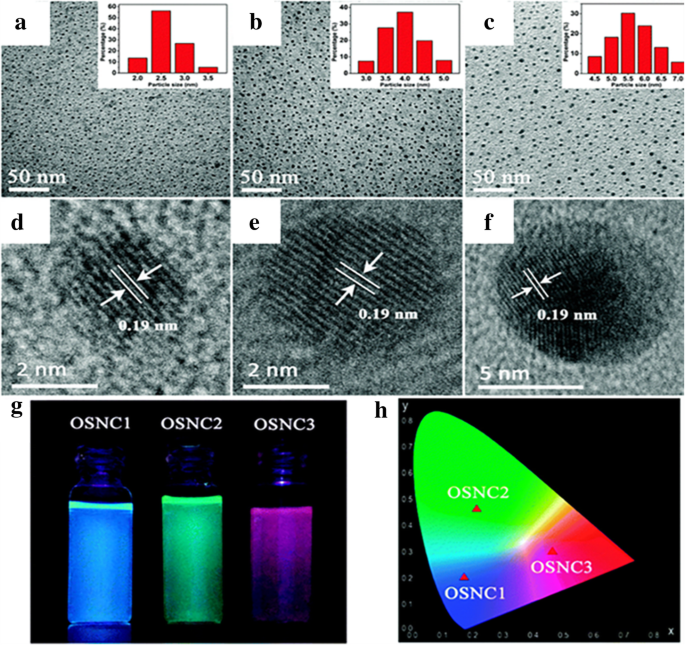
Kenmerken van OSNC's:a –c als TEM-afbeeldingen en d –f als hoge resolutie transmissie-elektronenmicroscopie (HRTEM) beelden. g De foto's van OSNC-monsters zijn onderhevig aan UV-lichtverlichting. u De verdeling op het kleurendiagram van de Commission Internationale de l'Eclairage (CIE) [50]
Omgekeerde micro-emulsiemethode
De Stöber-methode is een eenvoudige en handige methode om LSN's te synthetiseren, maar reactieomstandigheden en initiële deeltjes die niet worden gecontroleerd, leggen beperkingen op aan de luminescerende kleurstoffen. Om dergelijke beperkingen te overwinnen, introduceerden Bagwe en Khilar [66] een water-in-olie micro-emulsiesysteem [67] tijdens de synthese van zilver gecoat met silica-nanocomposieten (figuur 11b). De initiële alkalische waterige oplossing van zilveren nanodeeltjes met TEOS werd ingekapseld in de waterdruppel met behulp van oppervlakteactieve stoffen. De voortgang van de hydrolyse van TEOS was hetzelfde als die van de Stöber-methode. Maar de hele vooruitgang was beperkt tot waterdruppels die werden omsloten door oppervlakteactieve stoffen, wat leidde tot een goed gecontroleerd systeem en monogedispergeerde nanodeeltjes van silica. De grootte van silica werd goed gecontroleerd door verschillende oppervlakteactieve stoffen en oplosmiddelen te selecteren en de verhouding van oppervlakteactieve stof tot water te veranderen. Wanneer de fluoroforen in water oplosbaar zijn, is het gemakkelijk om een homogene silicalaag op het oppervlak te vormen binnen de moleculen in de druppel. Nianfang Wang et al. [46] gesynthetiseerde luminescente, met silica beklede CdS/CdSe/CdS-nanodeeltjes via omgekeerde micro-emulsiemethode. Afbeelding 13 toonde de TEM-afbeeldingen van de synthetische QD's en QDs@SiO2 . De beschermde QD's vertoonden uitstekende zuur- en thermische stabiliteit. Het bood de mogelijkheid voor verdere aanpassingen om te voldoen aan speciale vereisten voor toepassingen.
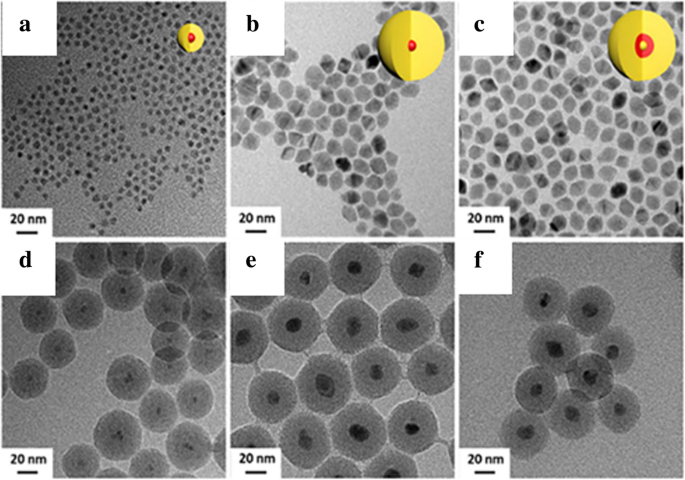
TEM-afbeeldingen van CdSe/CdS core/shell QD's met CdS thin shell (a ) en na coating met silica CdSe/CdS@SiO2 (d ); CdSe/CdS core/shell QD's met CdS shell (b ) en na coating met silica CdSe/CdS@SiO2 (e ); CdS/CdSe/CdS core/shell QD's (c ) en na coating met silica CdS/CdSe/CdS@SiO2 (f ) [46]
Direct Micelles Assistant Method
Reverse microemulsion method require the water-soluble luminescence dyes. Inversely, liposoluble initial micelles are the major features of direct micelle method, and the hydrolysis progress takes place around of the micelles (Fig. 11c). A precursor is indispensable for the agglomeration of silica. As a common progress, the luminescent dye is modified with the silane coupling agent, such as APS, to form the assistant micelles. The initial modified micelles ensure that the TEOS condensation occurs around them. Using Rhodamine B conjugated to APTES as the original micelle, Kumar et al. [26] successfully synthesized Rhodamine-conjugated organically modified silica nanoparticles in oil in water system and modified them with different function groups (such as sulfhydryl, amino, and carbonyl) which can be used as cell fluorescence probe.
The role of the surfactant is not only reflected in the silica synthesis but also in the synthesis of mesoporous silica. A common method of synthesizing mesoporous silica is calcination. Large specific surface area and modifiable surfaces make the mesoporous silica nanoparticles perfect carriers. In addition to the known application value in the field of medical drug loading, it also has important application prospects in the field of loading phosphors. Li Wang et al. [68] mixed up CDs with hollow mesoporous silica microspheres with good photochemical stability which can be used for oxygen detection in the whole range. Mesoporous structure makes them unique. Bin Xie et al. [69] incorporated the CdSe/ZnS core-shell QDs into mesoporous silica microspheres by a swelling and evaporation method. Coated with a mesoporous silica layer on the surface of Gd2 O3 :Eu phosphors via modified Stöber method is also feasible according to the Ali Aldalbahi et al. [70]. Because of the encapsulation of silica, the modified Gd2 O3 :Eu nanoparticles showed excellent solubility and biocompatibility.
Other Methods
There are also other methods to synthesize LSNs such as chemical vapor deposition (CVD) [71], hydrothermal method [51], and amino acid-catalyzed seed regrowth technique [72, 73].
Lianzhen Cao et al. [71] synthesized SiC/SiO2 by CVD and thermal annealing processes. Si was used to coat on the SiC core by thermal CVD and then SiO2 shell was obtained after oxidizing. The annealed SiC/SiO2 nanoparticles showed narrow luminescence in the blue-green region. The synthetic method provided a new way to synthesize core-shell nanomaterials.
Chandra et al. [51] synthesized smaller fluorescent silica nanoparticles (1 to 2 nm) with silicon tetrabromide (SiBr4 ) and APTS. Heating to 200 °C in an autoclave was the core step of the whole reaction. The final products were obtained after further purification including dialysis and centrifugation. The silica nanoparticles emitted bright blue luminescence with a photoluminescence quantum yield around 34%. It was non-photobleaching and biocompatible at the same time.
Surface modification makes the LSNs more tunable for complex application [74]. Silane coupling agents are the most common chemical methods as it mentions before. Abundant hydroxyl groups provide reaction sites for further modifications. Junqiang Wang et al. synthesized silica modified CeO2 ammonia sensor with high gas response due to hydroxyl groups [75]. After hydrolysis and condensation, silane coupling agents with different function groups bond on the surface of silica. Superhydrophobic silica was synthesized with the condensation of VTES (-CH=CH2 ) [76]. Ming Ma et al. grafted PEGMA and DMEAA on the surface by RAFT polymerization based on the -NH2 of APTS [77]. Surface modification can enhance their adaptability in complex environments and get improved luminescence properties with appropriate materials.
Among these methods, there are two main ideas to fabricate LSNs, namely the luminescent dyes are added directly into the reaction system when the silica resources start hydrolyzing, and that the luminescent dyes are established chemical bond with silica by other reagents such as silane coupling agents, either before or after silica network set up. It is necessary to select and design an appropriate synthetic route for LSNs with specific structures.
Applications of Luminescent Silica Nanoparticles
Light is the most intuitive tool for people to recognize the world. Luminescent materials with special emission can be directly used in many ways such as lighting, display, and so on. At the same time, changes in fluorescence intensity can reflect some important information. Compared with separate luminescent dyes, LSNs have improved performances in applications, since silica provides a stable matrix for the luminescent dye. It provides an effective way for multifunction at the same time [6]. LSNs with multifunction and tunable surface have great application prospects and development potential in biology, lighting, and sensors.
Biolabeling and Medicine
LSNs have great application value in biology. Non-toxicity is a fundamental requirement for medical field, especially in vivo [78]. The fact that the common luminescent dyes are often toxic limits their clinical application [79]. Silica, a favorite non-toxic modified material, is a good solution to elimination of toxicity. Toxicity of silica nanoparticles (20–200 nm) were also carefully studied by In-Yong Kim et al. [80]. Size, dose, and cell type-dependent cytotoxicity were the issues in their research. Although high dose can cause a disproportionate decrease in cell viability, the silica nanospheres with 60 nm showed their good biocompatibility up to 10 μg/ml. Different cells had different tolerance to silica nanoparticles which indicated that it was necessary to have substantial tests before clinical tests. Although inhalation of silica particles can cause acute and chronic diseases including silicosis [81], silica still has potential in biological application at the nanoscale. The toxicity of luminescent silica nanoparticles to living cells was studied in detail by Yuhui Jin et al. [38]. From the DNA level to the cell level, the toxicity of RuBpy-doped LSNs were carefully tested. At a certain concentration, the results showed that the dye-doped luminescent silica nanoparticles were non-toxic to the targeted DNA and cells, which indicate that LSNs are a good solution to the non-toxic modification. Xiqi Zhang et al. [27] encapsulated AIE dye (An18, derivatized from 9, 10-distyrylanthracene with an alkoxyl endgroup) into the silica nanoparticles via a one-pot modified Stöber method. Coated with silica lead to an enhanced fluorescence intensity, good water solubility, and non-toxicity to living cells which made the An18-SiO2 NPs had a potential for biomedical application.
LSNs have great application value in diagnosis and biolabeling. For hybrid imaging contrast agents, Dong Kee Yi et al. [48] combined magnetic particles (MPs) Fe2 O3 with QDs (CdSe) and encapsulated them in silica shell by reverse microemulsion method. The nanostructures of MPs with QDs are clearly showed in Fig. 14. Magnetic resonance imaging (MRI) is an effective method for disease detection, especially for cancer. The advantages of feasible usage, low cost, and accurate diagnosis make it more popular as a diagnostic tool [7]. The nanocomposites can be used as both optical and MRI contrast agents. It is worth mentioning that the presence of CdSe increased the effective magnetic anisotropy of the γ-Fe2 O3 -containg particles. This is a good attempt, but the low quantum yield (SiO2 /MP-QD 1.1% to CdSe 11.4%) limits the actual effect. Willam J. Rieter et al. [39] also synthesized the same multifunctional nanocomposites. What is different is that [Ru (bpy)3 ] Cl2 was chosen as the luminescent core and the paramagnetic Gd complex was coated on the luminescent core by water-in-oil reverse microemulsion method. The nanocomposites were finally embedded in silica in the same way. The results of Fig. 15 proved that hybrid silica nanoparticles had good optical and MRI performances in biological imaging. Mesoporous silica nanospheres doped with europium (Eu-MSN) were obtained by Mengchao Shi et al. [32]. Nanoscale size (280–300 nm) and fluorescent property were the basic for an ideal biolabeling material. They found that Eu-MSNs had a positive influence on osteogenesis and angiogenesis-induction. By promoting proper response of macrophages and the expression of relevant genes, the defect of bone replaced by new bone and the healing process of skin wound can accelerate with Eu-MSNs. Besides the function of biolabeling, the LSNs showed the potential in tissue repair. LSNs can achieve the target binding effect by modifying the special group. In Duarte’s work [33], organosilane Bpy-Si was chosen as a ligand of Eu complex for the further reaction with silica. SiO2 -[Eu (TTA)3 (Bpy-Si)] nanoparticles were obtained with a uniform size (28 ± 2 nm). With a further modification of an amino acid spacer and an anchor group (anti-Escherichia coli , IgG1), the functionalized silica had the specific bonding with E . coli bacteriën. It was easy to get the distribution of E . coli bacteria with luminescence. The bio-multifunction of LSNs was also carefully studied by Laranjeira et al. [82]. Gadolinium (Gd) composites with unique magnetic properties have potential in MRI contrast agents but Gd3+ ions are toxic in humans especially in kidneys and pancreas. GdOHCO3 nanoparticles were chosen as the MRI contrast core and coated with silica layer via Stöber method. With the silica coating, the Gd composite (SiGdOHCO3 ) had the same brightness of MRI contrast images but no degradation at designed pH values (5.5, 6.0, and 7.4). And SiGdOHCO3 had little effect on human fibroblasts according to the cell proliferation assay which indicated an excellent biocompatibility. Silica provides a more stable environment and further possible modification for GdOHCO3 without affecting MRI performance. By diverse micelles method, Atabaev et al. [83] synthesized Gd2 O3 :Tb 3+ ,Eu 3+ @SiO2 nanoparticles which can be used as both MRI contrast and fluorescence agents in vivo. The above two examples perfectly reflected the role of LSNs in multifunction with the silica platform.
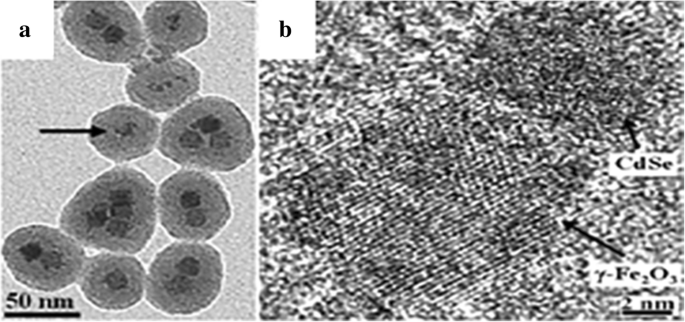
een TEM-afbeelding en b HRTEM image of SiO2 /MP-QD nanoparticles [48]
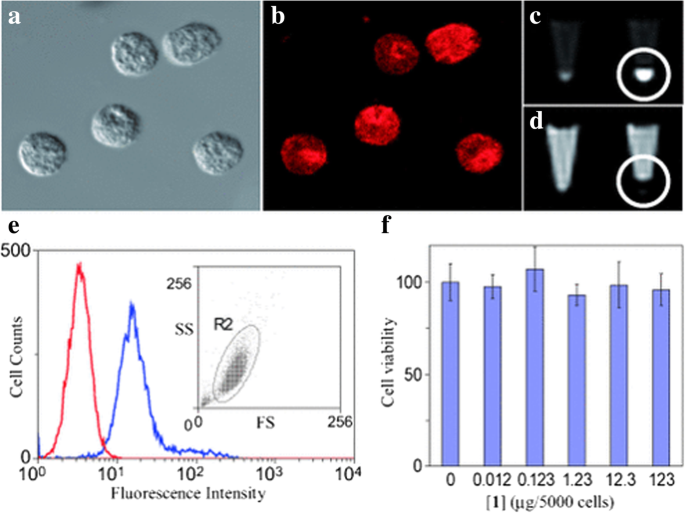
The imaging results of monocyte cells with a optical microscopic, b laser scanning confocal fluorescence, c , d the images of monocyte cells with MR:left for unlabeled monocyte cells and right for hybrid silica nanoparticles labeled monocyte cells, e flow cytometric results of blank and hybrid silica nanoparticles-labeled monocyte cells, and f the cell viability with different amount of hybrid silica nanoparticles [39]
LSNs have great application value in drug delivery. Hongmin Chen synthesized luminescent mesoporous silica nanoparticles biofunctionalized by targeting motifs, which makes them applicable in drug delivery [47]. They first prepared APS-containing mesoporous silica particles, and subjected the products to calcination at 400 for 2 h. They synthesized mesoporous silica by the help of cetyltrimethyl ammonium bromide (CTAB). There were luminescent carbon dots in the silica matrix after calcination. The fluorescence intensity was at the maximum when the particles were excited at 380 nm. The target selectivity of FL-SiO2 was achieved by surface modification of RGD peptide with the help of APS. They also studied the RGD-FL-SiO2 loading and release of doxorubicin (Dox). After calcination, fluorescent mesoporous silica (FL-SiO2 ) can still load Dox effectively. The porous structure was not affected by calcination. They found that RGD-FL-SiO2 had good luminescent effect especially around the blood vessels of tumor in vivo imaging studies. Integrin αv β3 of the tumor was the key of the interactions. Although there are many excellent attempts to apply LSNs to medicine but less successful clinical tests in human beings means that there is still a long way to go for the real medicine applications.
Light-Emitting Devices
Due to their special emitting features, LSNs also play a vital role in light emission fields including the field emission- and liquid crystal-based display technologies [84]. WLEDs have received recent attention for their broad applications including general illumination and displays. Tunable color, high color purity, and luminescence efficiency are in line with the requirements of light-emitting diodes (LEDs) [85]. Quantum dot-based light-emitting diodes (QD-LEDs) have demonstrated recently, and may offer many advantages over conventional LED and organic light-emitting diodes (OLEDs) technologies in terms of color purity, stability, and production cost, while still achieving similar levels of efficiency. In order to improve the performances of polymer dots (Pdots) as WLED phosphors, Kaiwen Chang et al. [49] introduced some Pdots with different emission wavelength into the Stöber system to get encapsulated. The silica-encapsulated Pdots showed the same luminescence properties but markedly enhanced photostability.
To reduce the manufacturing complexity required for achieving full-color displays, it is more desirable to use a common device structure to achieve high efficiency for three primary colors (blue, green, and red). QDs have been widely used in display field because of its unique luminescent properties, such as high luminescent intensity, narrow emission spectra, and tunable emission. Chun Sun et al. [34] synthesized the perovskite QDs, CsPbBr3 , as the light-emitting core of WLEDS. Only the perovskite QDs are not enough for a LED device since photostability and stability are necessary for an optical device under long-time work and elevated temperature. There are anion-exchange reactions between different halide QD nanoparticles which would widen the narrow emission spectrum. QD/silica composite were fabricated in APS to avoid oxidation and decomposition. So they used APTES as the QDs’ capping agent and improved the silica coating process to avoid the decomposition of the QDs. Green and red QD/silica composites were synthesized and a WLED was obtained by the combination of the composites with a blue LED chip. The WLED had good performances with great air stability as depicted in Fig. 16.
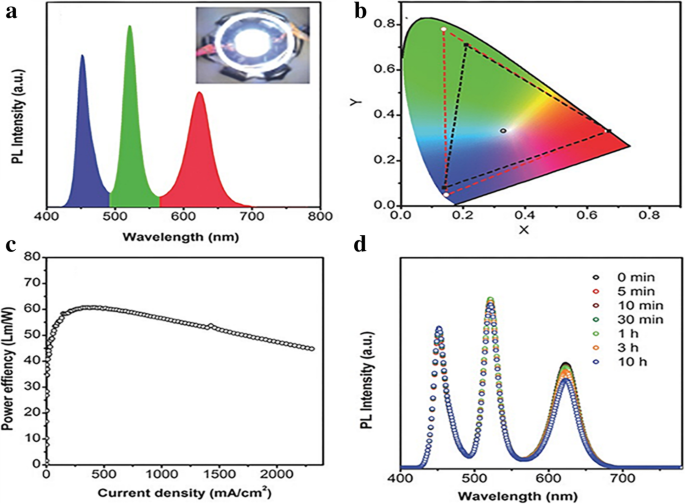
The optical performances of the WLED:a the emission spectra, b the CIE color coordinates and the color triangle of WLED (red dashed line) with the NTSC TV standard (black dashed line), c the power efficiency, and d emission spectra after working for a while [34]
LSNs can keep good dispersion, brightness, and photostability of QDs. Hung-Chia Wang et al. [35] provided a new composite method for QDs and silica (Fig. 17). By mixing the QDs with mesoporous silica powder of which pore size was bigger than that of QDs in non-polar solution, mesoporous silica green PQD nanocomposite was obtained after washing and drying. The quantum dot showed better thermal stability and photostability after composited with silica. On the other hand, QDs are a typical kind of aggregation-caused quenching (ACQ) nanoparticles, which means that it is necessary to keep a good dispersion to get a good brightness and photostability. Kai Jiang et al. [86] synthesized carbon dots with red, green, and blue luminescence with phenylenediamines as precursors to enhance luminescence properties as solution and poly (vinylalcohol) (PVA) film. But it would exist quenching effect as solid-state CDs which was fatal for LED devices owing to aggregation and the result Förster resonance energy transfer (FRET). To avoid the dispersion and the resulting FRET phenomenon, Junli Wang et al. [36] embedded carbon dots into silica matrix (Fig. 18) by dispersing carbon dots into the N -(3-(trimethoxysilyl)propyl) ethylenediamine (KH-792) and heating to form a homogenous CD/silica film. A white LED was fabricated by drying the CD/silica solution on the inner wall. By the assistant of silica, CDs were well dispersed with an appropriate distance without quenching which improve the performance as powders. Figure 18 showed the emission spectra and performance in WLED. And the CIE coordinates (0.44, 0.42) and correlated color temperature (CCT) (2951 K) suggested that it was suitable for indoor illumination.

een The formation progress of MP-CsPbBr3PQDs. b The luminescence intensity and the color triangle of WLED [35]
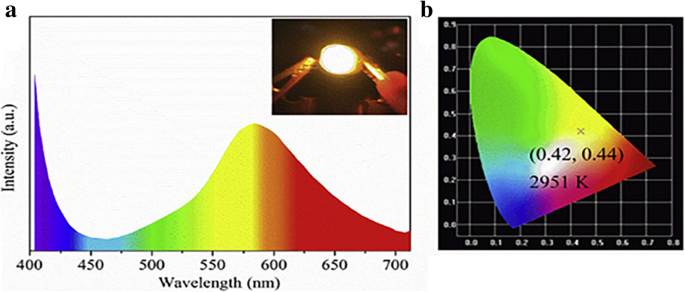
The performance of WLED showed as a the emission spectrum and b for CIE chromaticity and CCT [36]
Sensors
Luminescent silica showed the excellent performances on static luminescent materials, such as biolabeling and WLED phosphors. All these were based on their unique and stable optical properties. When it came to dynamic luminescent materials, LSNs also display the same wonder [9]. The luminescent sensors of pH [28], ions [87], and temperature [40] are following as representatives.
pH value have great influence on the luminescence intensity which inspires luminescent pH sensor. In the same principle as ref. [22], Atabaev et al. synthesized the same ratiometric pH sensor [28]. FITC was chosen as the pH-dependent luminescence dye and Y2 O3 :Eu 3+ as pH stable dye. With the Stöber coating of silica, Y2 O3 :Eu 3+ @SiO2 with FITC composite NPs were successfully synthesized. The change of pH was reflected by the ratio of fluorescence intensity (I FITC /Ik Y2O3:Eu3+ ). The standard dye led to a less influence of concentration and a more accurate result.
LSNs can also be used as ions sensors. Based on the changes of luminescence intensity with the measured physical quantity, LSNs have been applied to many sensor fields by the environment-dependent effect of the luminescence. Quenching effect is an effective detective tool to detect the changes of quenching factors such as ions and pH value with external quenching mechanisms such as FRET and photoinduced electron-transfer (PET) [9]. Sensors for metal ions are important fields whether in cells or open system. Won Cho et al. [37] synthesized europium (III) coordination polymer (EuCP) and found the specific quenching effect of Cu 2+ (Fig. 19). In view of this fact, they synthesized silica@EuCP microsphere which have the same sensitivity on Cu 2+ with less mass of europium. As an auxiliary material, silica can effectively reduce the amount of sensor materials. Both of them have their unique situations. Besides quenching effect, there are some different effects which can be used in the fields of sensors. 2,2-Dipicolylamine (DPA) and its derivatives have good affinity to heavy ions. And enhanced luminescence effect would happen after chelated with heavy ions. Yu Ding et al. [29] modified silica spheres with N ,N ′-bis (pyridine-2-ylmethyl)ethane-1,2-diamine (Fig. 20). The concentration of heavy ions (Cd 2+ Hg 2+ en Pb 2+ ) in samples can be determined by the change of fluorescence intensity. The test in real water samples and simulated biological samples confirmed the heavy metal ions-binding ability and the detection which has application prospects in the water monitoring and so on.
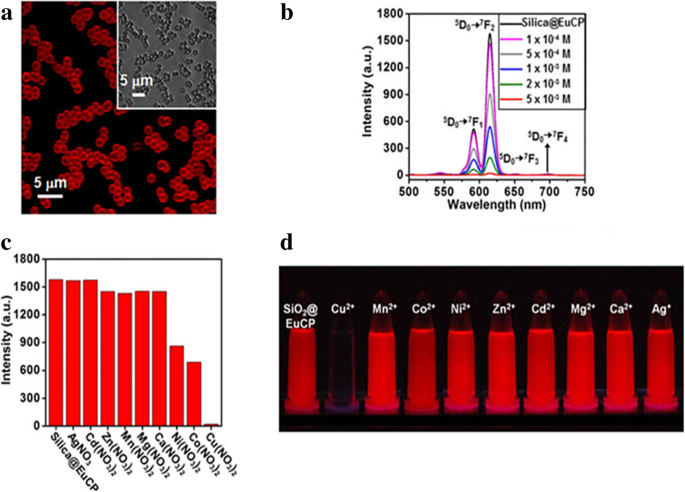
een Confocal microscopy and OM (inset) images of silica@EuCP microspheres. b Luminescence spectra with different Cu (NO3 )2 in MeCN; luminescence intensity changes (c ) and photograph (d ) with different metal ion solutions (5 mM) [37]
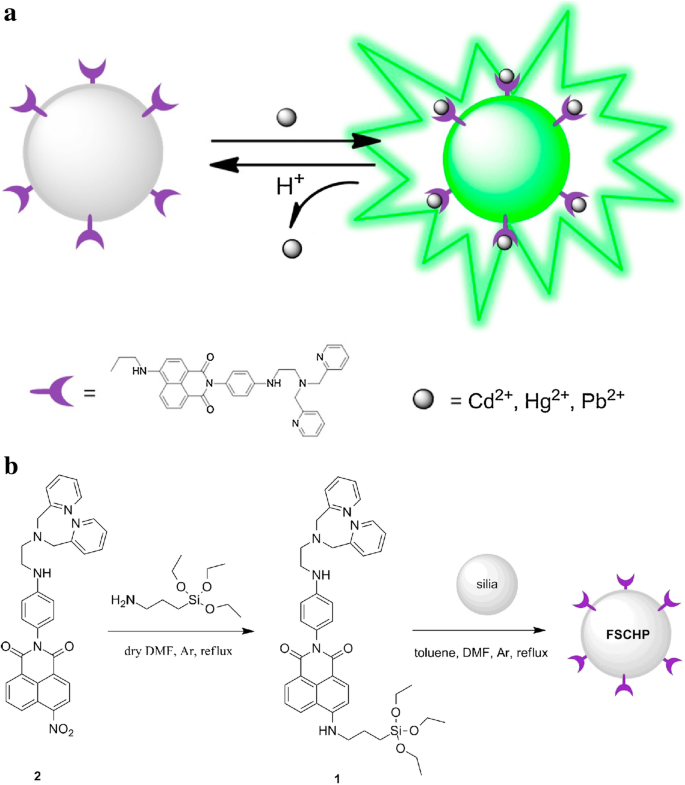
The formation and sensing progress scheme of sensitive fluorescent sensor (FSCHP) [29]
Temperature sensors are also important applications of LSNs. Temperature is a basic variable in most science fields. The temperature dependence of radiative and non-radiative transition rates is the core content of temperature sensing which makes it possible for luminescence temperature sensing, with the contactless and large-scale advantages [9]. However, in order to be applied in practice, their stability is crucial as the environment of application is more complex than of that of experiment condition. Silica is an ideal matrix to improve their performance for application. Mirenda et al. [40] synthesized silica as the core and then TEOS was hydrolyzed with Ru (bpy)3 Cl2 to form the Ru (bpy)3 @SiO2 NP's. The emission spectra of Ru (bpy)3 @SiO2 NPs (Fig. 21) showed that the intensity of Ru (bpy)3 @SiO2 NPs decreased linearly as the temperature rising as the result of the activated non-radiative 3 d-d state (20–60 °C, λexc = 463 nm). The polyethyleneimine (PEI)-modified glass with Ru (bpy)3 @SiO2 NPs showed the same trend as the NPs which proved that the potential as the temperature sensing. With cycling the temperature between 20 and 60 °C, the relative slope decreased until the seventh cycle which meant that it is necessary to condition to obtain the stable sensing materials. The influence of temperature on probes is complicated. So it is necessary to research the temperature-dependent luminescence of the probes to know how to apply it into temperature sensors. Temperature is a fundamental variable that governs diverse intracellular chemical and physical interactions in the life cycle of biological cells. The change of temperature reflects the level of cell metabolism. GdVO4 co-doped with Er 3+ (1 mol%) and Yb 3+ (1 mol%) has the potential to apply as the temperature sensor. To improve their performance as temperature sensor, Savchuk et al. [41] coated silica shell on the nanoparticles surface by Stöber method. The fluorescence intensity ratio (FIR) of Er, Yb:GdVO4 , ik 520 /Ik 550 , had a certain linear relationship with temperature in the range from 297 to 343 K after excitation at 980 nm. And the probes got enhanced thermal sensitivity, high thermal resolution and good stability in different solvents. And the result of the ex vivo experiment to monitor temperature evolution with the special sensor showed in Fig. 22 proved that Er, Yb:GdVO4 @SiO2 core-shell nanoparticles had a good thermal resolution as the temperature sensor in biomedical applications.
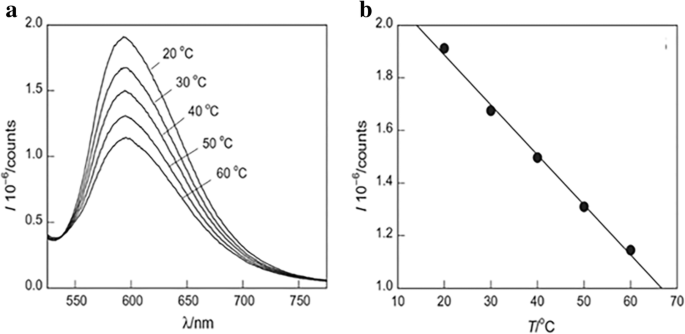
een PL spectra of Ru (bpy)3 @SiO2 under different temperature. b The peak intensity changes as a function of temperature [40]

een Ik 520 /Ik 550 with different temperature for Er, Yb:GdVO4 and Er, Yb:GdVO4 @SiO2 . b The sketch map for the ex vivo temperature determination experiment. c The results of the temporal evolution of temperature for the Er, Yb:GdVO4 @SiO2 and a thermoresistor Pt-100 [41]
Conclusie
In this article, LSNs with various functions demonstrate that silica is an ideal host material for luminescent dyes. The visualization of related parameters is the most special feature of luminescent dyes. Various luminescent materials have their own advantages but there are still some defects which limit their applications. Improved brightness, photostability, and thermal stability are the advantages of LSNs with the protection of silica. At the same time, it provides phosphors with a versatile platform which makes it possible to become multifunctional and specially modified. Excellent performance, adjustable adaptability, and potential versatility broaden the applications of fluorescent materials. LSNs have great potential in many unmentioned fields such as solar cells and photocatalysts. However, there is still a long way to apply LSNs to the actual species. Poor selectivity and low signal-to-noise ratio in complex conditions are factors that constrain LSNs for the practical applications which need to be further studied. Defined distances between phosphors and LSPR metal deserve more investigations to get the positive effect. Many new luminescent materials with excellent luminescence properties have been developed which means that it is necessary to improve the traditional synthetic methods to obtain LSNs. Silica is a traditional modified material but LSNs still have great potential for development.
Afkortingen
- ACQ:
-
Aggregation-caused quenching
- AIEgen:
-
Aggregation-induced emission luminogens
- AMP:
-
Adenosine 5′-monophosphate
- An18:
-
An aggregation-induced emission-based organic fluorogen derivatized from 9,10-distyrylanthracene with alkoxyl endgroup
- APS:
-
(3-Aminopropyl)triethoxysilaan
- APTES:
-
3-Aminopropyltriethoxysilane
- APTS:
-
(3-Aminopropyl)trimethoxysilane
- B:
-
Blue
- BAM:
-
Bio-anchored membrane
- CCT:
-
Corresponding correlated color temperature
- CD's:
-
Koolstofstippen
- CDSP:
-
Carbon dot-silica- phosphor composite
- CIE:
-
Commission Internationale de l’Eclairage
- CLSM:
-
Confocal laser scanning microscope
- CRI:
-
Kleurweergave-index
- CTAB:
-
Cetyltrimethyl ammonium bromide
- CVD:
-
Chemische dampafzetting
- DDT:
-
1-Dodecanethiol
- Dox:
-
Doxorubicine
- DPA:
-
2,2-Dipicolylamine
- F127:
-
Poly (ethylene glycol)-block-poly (propylene glycol)-block-poly (ethylene glycol)
- FIR:
-
Fluorescence intensity ratio
- FITC:
-
Fluorescein isothiocyanate
- FL-SiO2 :
-
Fluorescent mesoporous silica
- FRET:
-
Förster resonance energy transfer
- FSCHP:
-
Sensitive fluorescent sensor
- FSNP:
-
Fluorescent silica nanoparticle
- G:
-
Green
- H:
-
The ratio of water/TEOS
- HPTS:
-
8-Hydroxypyrene-1,3,6-tresulfonic acid
- HRTEM:
-
Hoge resolutie transmissie-elektronenmicroscopie
- IgG1:
-
Anti-Escherichia coli
- KH-792:
-
N-(3-(trimethoxysiyl)propyl)ethylenediamine
- LEDs:
-
Ligh-emitting diodes
- LSN:
-
Luminescent silica nanoparticle
- LSPR:
-
Local surface plasmon resonance
- MPS:
-
3-Mercaptopropyltrimethoxysilane
- MPs:
-
Magnetic particles
- MQDs:
-
Magnetic quantum dots
- MRI:
-
Magnetische resonantie beeldvorming
- MTT:
-
Methyl tetrazolium
- NIR:
-
Nabij-infrarood
- NTSC:
-
National Television System Committee
- OLED's:
-
Organische lichtemitterende diodes
- OSNC:
-
Organosilica nanocrystal
- OTES:
-
n-Octyltriethoxysilane
- PBS:
-
Fosfaatgebufferde zoutoplossing
- Pdots:
-
Polymer dots
- PEI:
-
Polyethyleneimine
- HUISDIER:
-
Photoinduced electron transfer
- PVA:
-
Poly (vinylalcohol)
- PVIS:
-
Poly (1-vinylimidazole-co-vinyltrimethoxysilane)
- QD655:
-
A kind of commercial quantum dots
- QD-LEDs:
-
Quantum dot-based light-emitting diodes
- QD's:
-
Kwantumstippen
- R:
-
Red
- R:
-
The ratio of water/surfactant
- RBL-2H3:
-
Rat basophilic leukemia mast cells
- SEM:
-
Scanning elektronenmicroscoop
- TEM:
-
Transmissie elektronenmicroscoop
- TEOS:
-
Tetraethoxysilane
- TPETPAFN:
-
A typical fluorogen consisting of two tetraphenylethylene pendants and an intramolecular charge transfer core
- TRITC:
-
Tetramethylrhodamine isothiocyanate
- UC:
-
Opconversie
- UCNP:
-
Upconversion nanoparticles
- UCNPs@SiO2@EuTP:
-
NaGdF4:Yb,Er@SiO2@Eu (TTA)3Phen
- UV:
-
Ultraviolet
- VTES:
-
Vinyltriethoxysilane
- WLED:
-
White light-emitting diode
Nanomaterialen
- Toepassing van wolfraam en wolfraamlegeringen
- Classificatie van kleurstoffen per toepassing
- Classificatie en toepassing van glasvezel
- Multifunctionele gouden nanodeeltjes voor verbeterde diagnostische en therapeutische toepassingen:een overzicht
- Voorbereiding van met ICA geladen mPEG-ICA nanodeeltjes en hun toepassing bij de behandeling van door LPS geïnduceerde H9c2-celbeschadiging
- Biogene synthese, karakterisering en antibacteriële potentiële evaluatie van koperoxide-nanodeeltjes tegen Escherichia coli
- Een overzicht van de toepassing van biosensoren en nanosensoren in agro-ecosystemen
- Eenvoudige synthese en optische eigenschappen van kleine selenium nanokristallen en nanostaafjes
- Nanogestructureerde Silica/Gold-Cellulose-Bonded Amino-POSS Hybrid Composite via Sol-Gel Process en zijn eigenschappen
- Eenvoudige synthese van gekleurd en geleidend CuSCN-composiet gecoat met CuS-nanodeeltjes
- Synthese en luminescentie-eigenschappen van in water oplosbare α-NaGdF4/β-NaYF4:Yb,Er Core–Shell-nanodeeltjes



